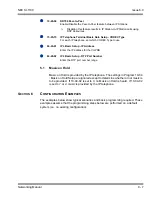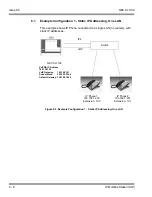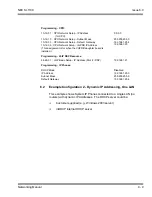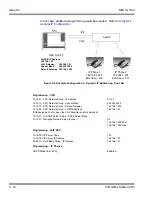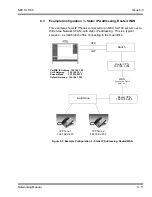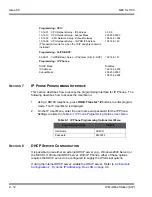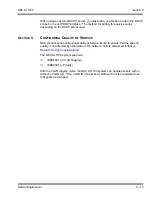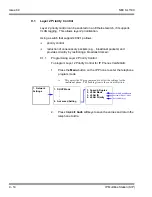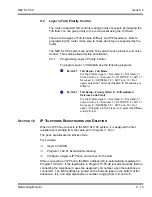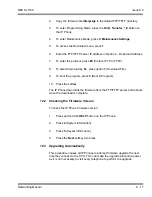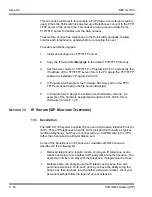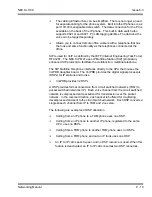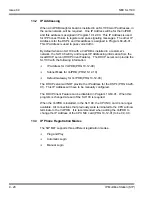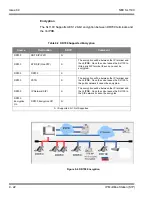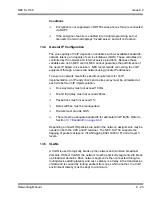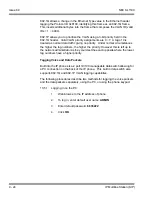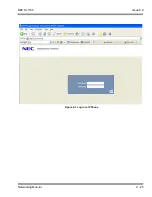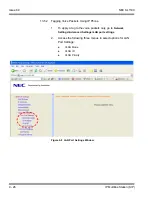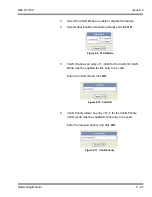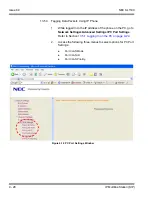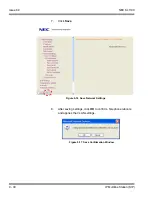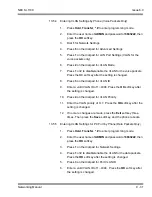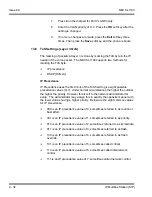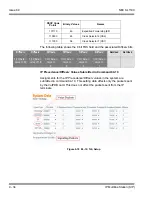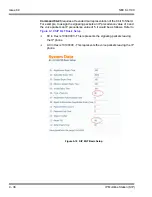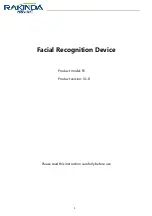
NEC SL1100
Issue 6.0
Networking Manual
9 - 21
Plug and Play Registration
Plug and play registration mode allows for no authentication. As long as an IP
terminal is configured with the proper IP addressing scheme, and plugged into
the network, the phone comes on-line. In plug and play mode you may assign
an extension number into the IP terminal or allow the system to automatically
set an unused extension number for the station. When the system assigns
unused extension numbers it starts searching for the first available port or
starts at a preassigned port and works its way up from there.
Automatic Login
When set to automatic login the SIP user name and password must be
entered in the configuration in the IP terminal. When the phone tries to
register with the CPU it checks the user name and password against its
database. If the user name and password match, the phone is allowed to
complete registration. If the user name and password do not match, the phone
cannot register with the CPU. The IP terminal displays an error message:
Unauthorized Auto Login
.
Manual Login
When set to manual login, no user name, password, or extension number is
entered into the configuration of the telephone. The user is prompted to enter
this user name and password into the IP phone. This information is cross
referenced in the phone system to an associated extension number. If a match
is found, the phone comes online. If there is no match, the phone cannot
complete registration with the CPU. The IP terminal either returns to the login/
password screen, or locks out the user and requires the administrator to
unlock the IP terminal. Lockout on failed attempts is dependent on system
programming. Manual mode is good for an environment where multiple users
share the same IP phone at different times. As one user logs out the next user
can login with their credentials and all of their associated programming
follows.
In Manual mode a user can also logoff the IP phone to allow another user to
login with their own login ID and password.
To logoff the IP Phone when the terminal is set to "Standard" softkey mode
(PRG 15-02-60) use the following operation: Press the "Prog" softkey, press
the "Down Arrow", press the "Down Arrow", press the "Down Arrow", and the
press "Logoff". The IP Phone can also be logged off by resetting the IP
terminal.
To logoff the IP Phone when the terminal softkey is set to "Advanced Mode 1/
2" (PRG 15-02-60) the IP terminal must be reset.
Summary of Contents for SL1100
Page 1: ...Networking Manual NDA 31190 Issue 6 0 SL1100...
Page 2: ......
Page 4: ......
Page 22: ...Issue 6 0 NEC SL1100 1 2 Introduction THIS PAGE INTENTIONALLY LEFT BLANK...
Page 62: ...Issue 6 0 NEC SL1100 5 30 Programming THIS PAGE INTENTIONALLY LEFT BLANK...
Page 94: ...Issue 6 0 NEC SL1100 6 32 Network Design Considerations THIS PAGE INTENTIONALLY LEFT BLANK...
Page 134: ...Issue 6 0 NEC SL1100 8 10 DHCP Client THIS PAGE INTENTIONALLY LEFT BLANK...
Page 159: ...NEC SL1100 Issue 6 0 Networking Manual 9 25 Figure 9 7 Log In to IP Phone...
Page 181: ...NEC SL1100 Issue 6 0 Networking Manual 9 47 Figure 9 25 IP System Operation Setup...
Page 206: ...Issue 6 0 NEC SL1100 9 72 IP Multiline Station SIP Figure 9 36 NAPT Configuration Example...
Page 230: ...Issue 6 0 NEC SL1100 10 18 IP Single Line Telephone THIS PAGE INTENTIONALLY LEFT BLANK...
Page 232: ...Issue 6 0 NEC SL1100 11 2 NAPT Figure 11 1 NAPT Configuration Example...
Page 242: ...Issue 6 0 NEC SL1100 12 4 All DSP Busy Indication THIS PAGE INTENTIONALLY LEFT BLANK...
Page 290: ...Issue 6 0 NEC SL1100 13 48 SL Net THIS PAGE INTENTIONALLY LEFT BLANK...
Page 291: ......
Page 292: ...SL1100 Networking Manual NEC Corporation of America Issue 6 0...

